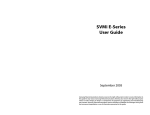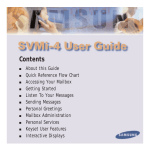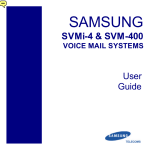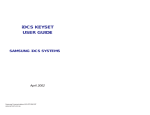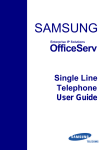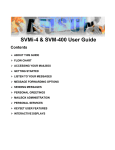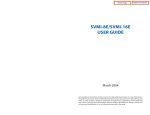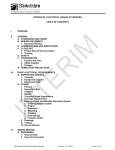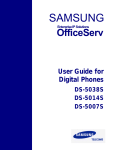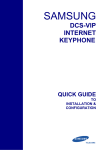Download Samsung SVMi-8 User's Manual
Transcript
Samsung
SVMi-8
Complete Integrated Voice Processing
User Guide
Every effort has been made to eliminate errors and ambiguities in the information contained in
this guide. Any questions concerning information presented here should be directed to
Samsung Telecoms (UK) Ltd.
Samsung Telecoms (UK) Ltd disclaims all the liabilities for damages arising from the erroneous
interpretation or misuse of information presented in this guide.
EU Declaration of Conformity (RTTE)
Samsung Electronics Co., Ltd.
EU Declaration of Conformity (RTTE)
Samsung Electronics Co., Ltd.
259 Gongdan-Dong, Gumi-City Kyungbuk, Korea, 730-030
(factory name, address)
259 Gongdan-Dong, Gumi-City Kyungbuk, Korea, 730-030
(factory name, address)
declare under our sole responsibility that the product
Digital Keyphone System "DCS"
declare under our sole responsibility that the product
Digital Keyphone System "DCS Compact II"
to which this declaration relates is in conformity with
RTTE Directive 1999/5/EC ( Annex II )
Low Voltage Directive 73/23/EEC
EMC Directive 89/336/EEC:92/31/EEC
to which this declaration relates is in conformity with
RTTE Directive 1999/5/EC ( Annex II )
Low Voltage Directive 73/23/EEC
EMC Directive 89/336/EEC:92/31/EEC
By application of the following standards
EN55022 : 1998 Inc A1: 2000*
.........................................................................................
EN61000-3-2:1995 Inc. A1/A2:1998
.........................................................................................
EN61000-3-3:1995, EN61000-4-2:1995 Inc. A1:1998, EN61000-4-3:1996 Inc. A1:1998
.........................................................................................
EN61000-4-4:1995, EN61000-4-5:1995, EN61000-4-6:1996, EN61000-4-8:1993
.........................................................................................
EN61000-4-11:1994, AS/NZS3548:1995
.........................................................................................
EN60950 ; 1992+A1+A2+A3+A4+A11
By application of the following standards
EN55022 : 1998 Inc A1: 2000*
.........................................................................................
EN61000-3-2:1995 Inc. A1/A2:1998
.........................................................................................
EN61000-3-3:1995, EN61000-4-2:1995 Inc. A1:1998, EN61000-4-3:1996 Inc. A1:1998
.........................................................................................
EN61000-4-4:1995, EN61000-4-5:1995, EN61000-4-6:1996, EN61000-4-8:1993
.........................................................................................
EN61000-4-11:1994, AS/NZS3548:1995
.........................................................................................
EN60950 ; 1992+A1+A2+A3+A4+A11
.........................................................................................
.........................................................................................
.........................................................................................
.........................................................................................
(Manufacturer)
(Manufacturer)
Samsung Electronics Co., Ltd
259, Gongdan-Dong, Gumi-City
Kyungbuk, Korea, 730-030
Samsung Electronics Co., Ltd
259, Gongdan-Dong, Gumi-City
Kyungbuk, Korea, 730-030
TE Jang
2001-03-31
.................................................
Tae-eok Jang / General Manager
.................................................................................
TE Jang
2001-03-31
.................................................
Tae-eok Jang / General Manager
.................................................................................
(place and date of issue)
(name and signature of authorized person)
(place and date of issue)
(name and signature of authorized person)
(Representative in the EU)
(Representative in the EU)
Samsung Electronics Euro QA Lab.
Blackbushe Business Park
Saxony Way, Yateley, Hampshire
GU46 6GG, UK
Samsung Electronics Euro QA Lab.
Blackbushe Business Park
Saxony Way, Yateley, Hampshire
GU46 6GG, UK
IS Lee
2001-04-03
.................................................
In-Seop Lee / Manager
...............................................................................
IS Lee
2001-04-03
.................................................
In-Seop Lee / Manager
...............................................................................
(place and date of issue)
(name and signature of authorized person)
(place and date of issue)
(name and signature of authorized person)
Table of Contents
Publication Information
About This Book
1
Accessing your Mailbox
2
Getting Started
3
Listen to your Messages
3
Subscriber Main Menu
3
Listening to Old or New Messages
4
Group New or Old Messages
5
Record and Send a Message
6
Access Manager
8
Samsung Telecoms (UK) Ltd reserves the right without prior notice to revise
̤Á information in this
publication for any reason.
Samsung Telecoms (UK) Ltd also reserves the right without prior notice to make
º¸Ñ¤ ¶¹
any changes in
design or components of equipment as engineering and manufacturing may warrant.
Copyright © 2002
Samsung Telecoms (UK) Ltd
All rights reserved. No part of this manual may be reproduced in any form or by any means—
graphic, electronic or mechanical, including recording, taping, photocopying or information
retrieval systems—without express written permission of the publisher of this material.
SVMi-8 Telephone Keypad Interface
10-11
Personal Greetings
12
Mailbox Administration
14
Message Broadcast
16
Personal Services
16
Personal Administration Settings
18
Keyset User Features
19
Message Waiting Lights
19
Answer Machine Emulation
19
AME Password
20
Call Record
20
Shortcuts
21
Calling
21
Being Called
21
Direct Messaging
21
Self Memo
21
Interactive Displays
Viewing Mailbox Contents
21
21
About This Book
This user guide describes how to set up your mailbox, and how to use the various
mailbox owner features. Please read this guide carefully before you use your mailbox. See the SVMi-8 Telephone Keypad Interface diagram for quick reference.
Your voice mailbox can store private messages, offers a number of options for
sending or redirecting messages, and provides several ways to notify you of
new messages or calls.
This guide can be used by mailbox owners from within the office or from telephones
outside the office. The basic operation is the same, but the access method will be
different.
Note that some features and prompts detailed here may not be available to all mailbox owners. See your System Administrator if you have questions about feature
availability.
1
Accessing your Mailbox
Getting Started
Outside Callers
Using your new SVMi-8 mailbox is as simple as following a few simple spoken
instructions. First-time users should read this user guide as a tutorial. You should
start with the following steps:
!
Your phone must be set to forward to voice mail.
1. Dial your phone (DDI) number. The main greeting will answer.
2. Dial [#] and enter your personal mailbox password (the default password is
"0000"). See "What To Do Now", below.
Note: If you dial in on another number, you should dial [ ] [#] followed by your
mailbox (extension) number and password when prompted.
!
Access your mailbox á As described above.
!
Record a personal greeting á Dial [5] from the Subscriber Main Menu.
!
Change your access code, record your name and enter your directory name
á Dial [#7] from the Subscriber Main Menu.
Inside Callers
After you have completed these steps, your mailbox is set up and ready to use.
1. Dial the SVMi-8 access number or press the key assigned to ring SVMi-8,
[VMMSG].
Listen to your Messages
2. Enter your personal mailbox password when prompted (the default password
is 0000). See "What To Do Now", below.
Access your Mailbox from a Station other than your Own
(or checking a mailbox associated with a different station)
If there are new messages in your mailbox and you have a [VMMSG] key, the
key will be lit. Call the SVMi-8 by pressing this key, or dialling the access number,
and enter your password when prompted. You will then be at the Subscriber Main
Menu. Select [1] to listen to new messages or [3] to listen to saved messages.
1. Press the [VMMSG] key or dial the SVMi-8 access number and enter your password when prompted.
Subscriber Main Menu
2. Press [✱]. This will take you to the Main Auto Attendant Menu.
The following is a list of all the options available in the Subscriber Main Menu:
3. Press [# ] plus the mailbox number of your choice and enter your password when
prompted.
1
What To Do Now
You hear a message stating the number of messages left in your mailbox. You then
hear the Mailbox Owner Main Menu and can select one of the following options:
LISTENING TO NEW MESSAGES
11 GROUP NEW MESSAGES
2
SENDING A MESSAGE
3
LISTENING TO OLD MESSAGES
33 GROUP OLD MESSAGES
1
Listen to New Messages - See Listen to Your Messages.
4
ACCESS MANAGER
2
Record and Send Message - See Record and Send a Message.
5
PERSONAL GREETINGS
3
Review Saved Messages - See Listen to Your Messages.
6
MAILBOX ADMINISTRATION
5
Personal Greetings - See Personal Greetings.
8
PAUSE / RESUME
6
Mailbox Administration - See Mailbox Administration.
0
PLAY OPTIONS
#
Personal Services - See Personal Services.
✱
EXIT TO AUTO ATTENDANT
✱
Return to Main Menu
#
PERSONAL SERVICES
2
3
1 or 3
#
Move to the next message.
This does not Save or Discard the current message - it is retained as new.
## Scan. Plays first 7 seconds of a message then skips to next message.
LISTENING TO OLD OR NEW MESSAGES
1
Play / replay the message you just heard.
11 Play the previous message.
2
Save the message you just heard and listen to the next message.
3
Delete the message you just heard and listen to the next message.
4
Reply to the message.
This will allow you to leave a message in the mailbox of the sender (if the
sender has a mailbox on this system).
5
6
✱
Cancel and return to previous menu.
11 or 33
GROUP NEW OR OLD MESSAGES
Return the call directly to the telephone number that left the message.
Messages can be grouped as either Reminders -- press [3] -- or Messages from
a specific sender -- press [9].
This will work for internal and external callers, but Caller ID service is needed to
use this feature on an outside call.
Additionally you can press [#] and hear a summary of your mailbox contents:
Forward the message and save a copy.
The subscriber can be selected by dialing the mailbox number (nnn), using the
directory service (#) or you may also add comments and leave it as a memo to
yourself (##).
The Send and Copy Service (option 6) allows you to send copies of a message
to multiple recipients easily. A different introduction message may be left for
each recipient.
7
This is similar to the scan button on a radio. It will allow you to find a specific
message quickly. To stop scanning press [1].
a)
Number of messages
b) Number of reminders
c)
Number of urgent messages
d) Number of messages needing a callback
e)
Number of private messages
Rewind the message 5 seconds.
77 Change playback volume of the recording.
There are two levels of volume during playback. Dialing this code will toggle
between the two levels.
8
Pause or resume during message playback.
9
Fast forward the message 5 seconds.
99 Change playback speed of the recording.
There are two levels of speed during playback. Dialing this code will toggle
between the two speeds.
0
Play help options.
Pressing this key will play all the menu options available to you.
00 Hear the time and date and sender's information of the message you just
heard. Sender information is not available on outside calls.
4
5
Scheduling Future Delivery
2
RECORD AND SEND A MESSAGE
If after recording a message you select [5] to schedule future delivery, you will be
able to set message attributes and set this message as:
This option is used to send a message to another subscriber. The steps are:
#
Immediate Delivery
1
Next Few Hours
2
End of Current Business Day
3
Beginning of Next Business Day
4
A Coming Day of the Week
a)
Enter the recipient’s mailbox number, or if this is not known enter [#] to use the
system directory.
b) Record your message at the tone. After recording the message, you will hear
the Send Menu with the following functions:
1
Review
5
Specific Day / Time
2
Continue Recording
✱
Exit
3
Discard and Re-record
4
Set Message Attributes (Delivery Options)
5
Schedule Future Delivery
6
Send a Copy to Someone Else
#
Save the Recording
Setting Message Attributes
If after recording a message you select [4] you can set up any combination of the
following delivery options:
1
Urgent Delivery
2
Return Receipt Requested
3
Request a Call Back
4
Private Delivery
5
Reply Required
✱
Exit
6
7
6 Find Me
4
This option is available only if the Administrator has assigned you this feature.
ACCESS MANAGER
The Access Manager allows you to set a number of options for when, where and
how the SVMi-8 contacts you when a caller dials your extension number.
These options must be allowed by the System Administrator. They are:
1 Follow Me
This option is available only if the Administrator has assigned you this feature.
Allows you to enter an alternate location and set how long the new destination
will be active. This number may be an internal or external number.
This is useful if you are frequently travelling or changing the number where you
can be reached.
When Follow Me is activated, the transfer will be supervised. This means that if
the call is not answered at the destination it will be recalled to the owner’s mailbox.
Find Me, when enabled, will attempt to locate you by calling a list of pre-programmed phone numbers. The stored phone numbers are entered in
'Personal Services' (if allowed by the Administrator).
7 Night Intercept
This option is available only if the Administrator has assigned you this feature.
This feature is dependent on your weekly availability schedule, which is entered
in 'Personal Services' (if allowed by the Administrator). When active, the
SVMi-8 will play your primary, No Answer greeting during the day and your
Night greeting during the night.
8 Pause / Resume
9 Play Current Options (Access Profile)
✱ Exit from Access Manager
3 Call Blocking
This option is available only if the Administrator has assigned you this feature.
When this feature is active, callers will not be transferred to your extension.
They will hear your 'blocked' greeting (if recorded) and go directly to your mailbox.
0 Play All Options
# Play Access Coverage
4 Call Forwarding
This option is available only if the Administrator has assigned you this feature.
This allows the Administrator to set up a default 'other destination' that you
can turn on and off. When Follow Me is activated, the transfer will not be
supervised. This means that if the call is not answered at the destination,
it will not be recalled to the owner’s mailbox.
5 Call Screening
This option is available only if the Administrator has assigned you this feature.
If this is turned on, the caller will be asked their name and the SVMi-8 will play
this name to you before the transfer, giving you an option to accept or reject the
call.
8
9
1 & 3
While Listening
to Messages
1
2
Save Msgs
Previous Msgs
Save
Message
4
Call Sender
11
3
Discard
Messages
5
Reply to
Sender
6
8
Forward 5 Secs
Rewind 5 Secs
Change Speed
Change Volume
7
9
Pause,
Resume
77
Change Volume
99
0
✱
#
Play Options
Skip Messages
Msg Information
Scan Messages
00
##
7
77
✱
4 Access Manager Menu
1
2
3
Call
Blocking
Follow Me
4
5
Call
Forwarding
Find Me
8
9
7
Auto Set
Night
Intercept
Pause,
Resume
✱
1
Access
Profiles
0
Cancel
Executary
7
6
Call
Screening
#
Play
Options
Play Access
Coverage
Personal Admin
2
3
Change
Password
Record
Name
Enter
Directory
Name
4
5
6
8
9
0
#
Extended
Prompting
7
✱
Cancel
Executary
Pause,
Resume
Play
Options
Private
Messages
8
Forward 5 Secs
9
7
11
Group New Msgs
4
Access
Manager
7
Private
Access
Numbers
✱
Exit
Executary
2
Record & Send
Message
3
Saved Msgs
33
Group New Msgs
5
6
Mailbox
Admin
8
9
Pause,
Resume
0
#
Personal
Services
# Personal Services
1
Workload
Management
4
7
Personal
Admin
✱
Cancel
Executary
2
3
Weekly
Availability
Schedule
5
6
8
9
Pause,
Resume
0
Play
Options
9
8
Specific
Sender
Pause,
Resume
0
Cancel
Executary
#
Play
Options
Message
Inventory
1
3
2
Primary
No Answer
Greeting
Call
Blocking
Greeting
Busy
Greeting
5
4
Night
Greeting
6
Call
Screening
Greeting
Edit
Personal
Greeting
8
9
0
#
7
Edit
Mailbox
Greeting
Pause,
Resume
✱
Cancel
Executary
Play
Options
6 Mailbox Administration
Stored
Telephone
Numbers
Place a
Direct Call
6
5 Personal Greetings
Personal
Greetings
Play
Options
5
Fax
Messages
✱
#
MAIN MENU
1
Reminders
Change Speed
SEND,
NO Copies
3
Callback
Request
99
Play
Options
New Messages
2
4
6
SEND,
then Copy
0
Cancel
Executary
1
Schedule
Future
Delivery
Pause,
Resume
Group Messages
Urgent
Message
Discard
Rerecord
5
4
Delivery
Options
11 & 33
3
Stop
Recording,
Append
Deliver Fax Copy
Rewind 5 Secs
#
2
1
Review
Recording
Forward
a Copy
55
Cancel
Executary
2 While Recording Messages
#
Record a
Reminder
1
Message
Alert
4
Undelivered
Messages
7
✱
Cancel
Executary
SVMi-8 Telephone Keypad Interface
2
Pager
Notification
5
Auto Play
New
Messages
8
3
Deleted
Messages
6
Auto Play
Message
Information
9
Pause,
Resume
Broadcast
Message
0
#
Play
Options
3 Call Blocking Greeting
5
Used while Call Blocking is enabled.
PERSONAL GREETINGS
The options available in this menu will be determined by your System Administrator,
and not all of them may be available to you. In the simplest systems, only a mailbox
greeting will be available. Additional greetings may be accessible in more complex
systems.
Your Personal Greeting will be played every time someone dials your extension and
you do not answer.
You may record up to nine Personal Greetings, and you may assign any one of them
to be active.
There are several different 'Call Coverage' conditions to which you may assign any
of your nine greetings. This will allow different greetings to play depending on the
type of call, or the condition of your telephone.
The Call Coverage conditions that you can assign specific greetings to are selected
by the following digits:
1 Primary No Answer Greeting
Used when in your office, away from your desk or during the period you are
scheduled available.
This option is available only if the Administrator has assigned you the 'Basic
Greeting' feature.
Example: “Hi this is John Smith. I'm sorry I am not available to answer your
call. If someone else can help you, please enter the extension number now. Or,
to leave me a message, press 1.”
2 Busy Greeting
Used when talking to someone on your extension or the telephone at your
Designated Location.
This option is available only if the Administrator has assigned you the 'Busy
Greeting' feature.
Example: “Hi, this is John Smith. I'm on another line right now. Please choose
from the following options.”
12
This option is available only if the Administrator has assigned you the 'Call
Blocking' feature.
Example: “Hi, this is John Smith. Sorry I missed your call, but I'm going to be
out of the office for the next few hours. Please choose from the following
options.”
4 Night Greeting
Used during the time period you are NOT scheduled available, usually after
business hours during the evening and at night.
This option is available only if the Administrator has assigned you the 'Auto
Night Intercept' feature.
Example: “Hi, this is John Smith. I've left the office for the evening. Please
choose from the following options.”
5 Call Screening Greeting
Used while Call Screening is enabled, you REJECT a caller after listening to the
caller's record name.
This option is available only if the Administrator has assigned you the 'Call
Screening' feature.
Example: “Hi, this is John Smith. I'm sorry, but I just cannot speak with you at
this time. Please choose from the following options.”
You may also edit each one of the greetings (1-9).
6 Edit Personal Greetings
Follow the instructions to record your greeting message. When you are done
recording your message, you will be able to listen to the message you recorded,
save the message you recorded and return to the previous menu, record the
message again, or exit without saving the message.
Note: If you record only the greeting assigned to the No-Answer Call Coverage
Condition, then that greeting will play to callers for all Call Coverage Conditions
(No-Answer, Busy, Blocked, Night, and Rejected Caller). In this case, the salutation part of the greeting should be very general.
13
7 Edit Mailbox Greeting
Used whenever a caller reaches your mailbox.
!
Press [2] for pager notification.
!
There are four options available to you:
Press [1] to toggle pager notification on and off.
This option is available only if the Administrator has assigned you the 'Mailbox
Greeting Option' feature.
Press [2] to set the schedule when you would like to be paged.
Example: “Hi, this is John Smith. Please leave me a message, I will call you as
soon as I can.”
Note: This greeting will only play if none of the five personal greetings has played
to the caller.
Press [4] to set the pager phone number.
3 Undelete
When this function is activated, the SVMi-8 will allow you to undelete any messages that you have recently deleted (up to 3 a.m. the following morning).
6
MAILBOX ADMINISTRATION
The Mailbox Administration menu is used to turn on and off your pager notification,
message alert options and other sent message control features.
1 Message Alert
When this function is activated, the SVMi-8 will call any outside or internal telephone number, after each message is left in your voice mailbox.
To hear your message at the remote location, pick up the telephone and enter
your access code.
!
From the Mailbox Main Menu press [6] for Mailbox Administration.
!
Press [3] for Deleted Messages.
Deleted voice mail messages are temporarily stored in memory until 3 a.m. the
following day. Select this option to recover ("undelete") previously deleted messages during this period.
4 Undelivered Retrieval
When this function is activated, the SVMi-8 will allow you to recall any messages you have sent that have not yet been picked up by the recipient.
!
From the Mailbox Main menu press [6] for Mailbox Administration.
!
From the Mailbox Main Menu press [6] for Mailbox Administration.
!
Press [1] for Message Alert.
!
Press [4] for Undelivered Messages.
!
There are four options available to you:
This feature will allow you to cancel any messages that have not yet been
picked up by the recipient.
Press [1] to toggle message alert on and off.
Press [2] to set the schedule when you would like to be notified.
Press [3] to be notified on urgent messages only.
Press [4] to set the destination phone number.
2 Pager Notification
When this function is activated, the SVMi-8 will call your beeper service and
notify you after each message is left in your voice mailbox.
!
14
Press [3] to be notified on urgent messages only.
5 Auto Play New Messages
If this option is enabled, after you enter your password correctly any new messages will immediately begin to play. To enable this feature:
!
From the Mailbox Main Menu press [6] for Mailbox Administration.
!
Press [5] to Set Auto Play of New Messages.
From the Mailbox Main Menu press [6] for Mailbox Administration.
15
6 Auto Play Message Information
If this option is enabled, the date, time and sender’s name will be played automatically before each message. If this is disabled, the information must be
requested manually by pressing '00'. To enable this feature:
!
From the Mailbox Main Menu press [6] for Mailbox Administration.
!
Press [6] to Set Auto Play of Message Information.
2 Stored Numbers
Allows you to enter up to 9 stored phone numbers. The first five of these are
used in the 'Find Me' feature, but any of them can be easily dialed, using only
one digit, from within your subscriber space. (See 5 - Place a Direct Call below).
3 Schedule Availability
Allows you to enter a weekly availability schedule for use with the Auto Night
Intercept feature. Follow the spoken directions to enter the weekly days and
times of your availability.
9
MESSAGE BROADCAST
This option will only be available if it has been allowed by the System Administrator.
Broadcast to All Mailboxes
If you have been designated as a System Administrator, you may send a message to all mailboxes in the system.
!
From the Mailbox Main Menu press [6] for Mailbox Administration.
!
Press [9] for Broadcast Messages.
5 Place a Direct Call
Allows you to place a direct call out of the SVMi-8 from anywhere. You may
either dial the number or dial a single digit 1-5 that corresponds to a stored
number (See 2 - Stored Numbers - above).
7 Personal Administration
This area is used during the initial set up of your mailbox (see next section).
This option will only be available if your mailbox has been assigned System
Administration privileges.
#
PERSONAL SERVICES
The Personal Administration Menu is used to set your password and record your
name. Each of these features must be allowed by the System Administrator.
1 Workload Management
Allows you to group your reminders as Commitments, Follow-Ups or Tasks for
better organization. You may further define these as Active or Pending (pending
means scheduled for future delivery).
16
17
Personal Administration Settings
Keyset User Features
This menu allows you to set options that are rarely changed. Use these when
you initially set up your mailbox. You probably will not need them after that.
The following options are available if you have a display keyset. They require setup
by the System Administrator.
1 Setting your Password
Message Waiting Lights
!
!
From the Main Mailbox Menu press [#].
Press [1]. The current password will be played and you will have the
chance to change it.
2 Recording your Name
Use this option to record your name. Your recorded name is played in several
different situations. It is important to record your name for proper operation of
the SVMi-8 system.
!
!
From the Main Mailbox Menu press [#].
Press [2]. The current name will be played and you will have the chance to
change it.
3 Entering your Directory Name
Use this option to enter your Directory Name. Your Directory Name is used by
callers to find you if they do not know your extension number.
!
!
From the Main Mailbox Menu press [#].
Press [3]. The current Directory Name will be played as a string of digits
that are equal to your name spelled out on your telephone keypad. Follow
the instructions to enter a new name. You will be prompted to enter your
last name and then your first name.
This must be done in order for the directory feature to work correctly.
4 Extended Prompting
Use this option to drastically reduce the number of prompts played in the subscriber interface (mailbox prompts). Change this setting only if you are very
familiar with user operation of the SVMi-8.
18
When a new message is left in your mailbox, the voice mail message light on your
keyset will flash. Press this flashing key and follow the prompts to retrieve messages. This key may be pressed at any time to call your voice mailbox.
Answer Machine Emulation
If you have an Answer Machine Emulation key programmed on your keyset, you can
use it to monitor calls going to your voice mail, and optionally answer them. The
operation of this feature is similar to screening a call on a home answering machine.
Your keyset must be set to Forward on No Answer to voice mail. After ringing your
station the caller will be connected to your voice mail and hear your personal greeting before leaving a message. During this time you will be monitoring the connection between the caller and your voice mailbox. At this time you will only be monitoring the call; you cannot talk to the other party until you answer. You may pick up
the call at any time or ignore it.
To activate this feature press the AME key. It will light and the feature is set. Press
again to turn off. If this key is pressed while a station is ringing (during forward no
answer), the feature will be turned on for the current call only.
While the caller is leaving a message or ringing you may:
!
!
Press [#] to immediately put the caller in your voice mailbox and monitor it.
Press [✱] to immediately disconnect your station. The caller continues to leave
a message normally.
!
Pick up the handset and monitor privately.
!
Press ANS / RLS to answer the call (using the handset or speaker).
NOTE: If you do not want to hear your personal greeting during this process you can
turn on AME BGM in MMC 110 at your keyset. This will play background music at
your keyset instead of your personal greeting.
19
AME Password
Shortcuts
If your keyset has AME PASSWORD (MMC 110) set to YES, you must enter your
station password to listen to messages being left. This will prevent unauthorized
people from listening to messages being left for you.
Calling
If the password option is turned on, while a message is being left, press the flashing
AME light and enter your station password (not your SVMi-8 password). You will
then hear the message being left.
If calling a station that is busy or does not answer, you can press [#] to immediately
send the call to the called party's mailbox.
Being Called
Call Record
If your phone rings and you want to send the caller directly to your mailbox, simply
press [#].
If you have a call record button assigned to your phone, you may press it at any
time to record the conversation in progress. If you have a display keyset, you will
also have the soft key options to pause and time the message.
Direct Messaging
[#] + DSS To make it easy to leave messages for others in your office without having to dial their extension number first, you may simply dial [#] plus a mailbox
(extension) number and leave a message directly. If you dial a busy extension,
press [#] to connect directly with the mailbox.
Self Memo
Pressing [##] will leave a message in your own mailbox.
Interactive Displays
Display keyset users have the added advantage of using the soft keys and displays
to play, save, delete, reply, call, forward, rewind, pause, fast forward, change the
volume, get message information, or help.
Viewing Mailbox Contents
If you have new messages, in addition to the Message Waiting Light you will be able
to use the keyset displays and soft keys to communicate with the SVMi-8.
20
21
Samsung Telecoms (U.K.) Limited
Brookside Business Park, Greengate, Middleton, Manchester M24 1GS
Tel: 0161 655 1100 Fax: 0161 655 1166















